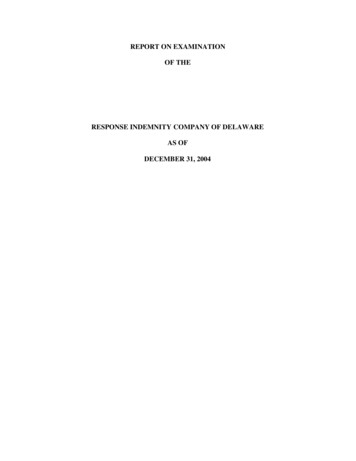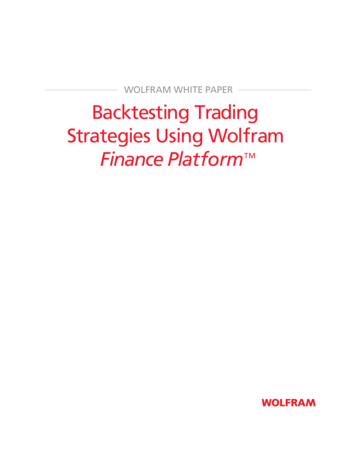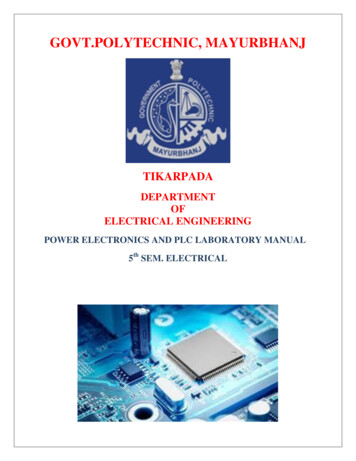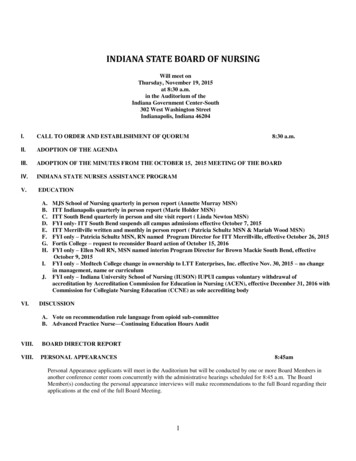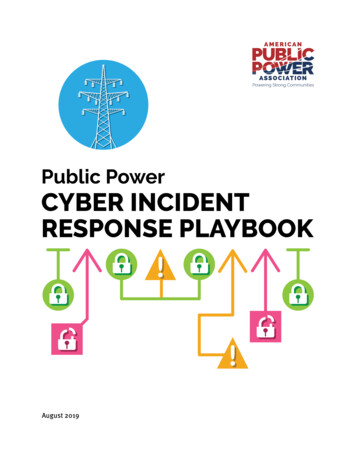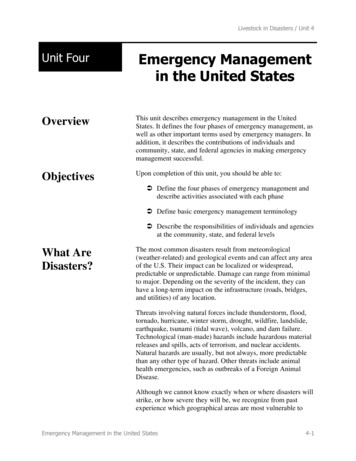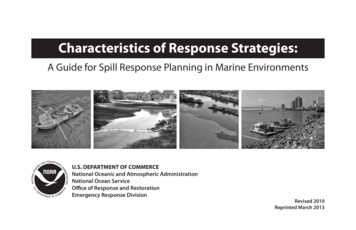
Transcription
Characteristics of Response Strategies:A Guide for Spill Response Planning in Marine EnvironmentsU.S. DEPARTMENT OF COMMERCENational Oceanic and Atmospheric AdministrationNational Ocean ServiceOffice of Response and RestorationEmergency Response DivisionRevised 2010Reprinted March 2013
Characteristics of Response Strategies:A Guide for Spill Response Planning in Marine EnvironmentsU.S. DEPARTMENT OF COMMERCE National Oceanic and Atmospheric Administration National Ocean Service Office of Response and Restoration Emergency Response DivisionRevised 2010Reprinted March 2013Seattle, WashingtonCharacteristics of Response Strategies: A Guide for Spill Response Planning in Marine Environments wasoriginally a joint effort between NOAA and the USCG. The original document was based on informationcontained in Environmental Considerations for Marine Oil Spill Response, published by the AmericanPetroleum Institute, National Oceanic and Atmospheric Administration, the U.S. Coast Guard, and the U.S.Environmental Protection Agency. The original printing was in 2001, NOAA revised the document in 2010.
TABLE OF CONTENTSIntroductionHow to Use this DocumentStrategies for Selecting Response MethodsGuidelines for Developing Response ActionsGoalsObjectivesStrategiesTacticsWindows of OpportunityIncident-specific Feasibility IssuesOn-Water Feasibility IssuesShoreline Feasibility IssuesProcess for Developing Incident-Specific StrategiesIntegration of On-water Response OptionsNatural RecoveryBoomingSkimmingBarriers/BermsPhysical HerdingManual Oil Removal/CleaningMechanical Oil 48VacuumDebris RemovalSediment Reworking/TillingVegetation Cutting/RemovalFloodingLow-pressure, Ambient-Water FlushingHigh-pressure, Ambient-Water FlushingLow-pressure, Hot-Water FlushingHigh-pressure, Hot Water FlushingSteam CleaningSand BlastingDispersantsEmulsion-treating AgentsElasticity ModifiersSurface Collecting AgentsSolidifiersSurface Washing AgentsNutrient Enrichment (Biostimulation)Natural Microbe Seeding (Bioaugmentation)In-situ 8697173753
TABLE OF CONTENTS (cont.)FIGURESTABLESFigure 1. T ypes of response options during amajor oil spill12Figure 2. O il thickness versus potential responseoptions19Figure 3. P rimary spill response options under variouswind/sea conditions and oil film thicknesses 24Table 1. I ncident-specific on-water strategy issuesTable 2. I ncident-specific shoreline strategy issues13154
IntroductionOil is a complex and variable natural substance. When released into the sea it can be transported long distances, undergovarious physical and chemical changes, and adversely affect marine ecosystems. Oil’s fate and effects depend on thetype and quantity of oil spilled, properties of the oil as modified over time by physical and chemical processes, theorganisms and habitats exposed, and the nature of the exposure. All of these factors should be considered when evaluating response methods. Interactions among these variables result in a large range of spill situations. Accordingly, spillresponders must determine the combination of response methods that best suits the spill situation.Response techniques have “windows of opportunity,” specific timeframes when each response method works the best.These windows are defined by the type of product spilled, the initial spill conditions, product weathering and emulsionrates, and the very different environments and ecosystems that are, or will be, impacted. When the methods are usedwithin these windows, they are more effective and less damaging to habitats and populations that survive the oil, reducing the time affected ecosystems need to recover.In every oil spill, government and industry decision-makers are presented with a unique set of challenges requiring timelyapplication of appropriate response methods. Two important questions that must be considered are: How does an on-scene coordinator or a responsible party sort through the myriad of options and select thosemethods that will effectively mitigate and clean up the oil? What is the rationale for selection?Characteristics of Response Strategies addresses these questions by providing information to decision-makers relatingto tradeoff decisions for specific habitats and response options. It focuses on maximizing response effectiveness whileminimizing resource impacts.Remember that the selection of a proper response method is highly dependent on incident-specific conditions, and thatthe strengths and weaknesses of a given response tool affect the suitability for its employment in a given habitat for a5
specific spill. Accordingly, using multiple methods simultaneously throughout an incident can produce a more effectiveresponse and minimize environmental impacts.Selecting response options, including natural recovery, involves considering tradeoffs among their potential environmental impact, appropriateness for habitat, and application timing.The 2001 Characteristics of Response Strategies and its companion guide, Characteristic Coastal Habitats: Choosing SpillResponse Alternatives (NOAA 2000), were based on information contained in Environmental Considerations for Marine OilSpill Response, published by the American Petroleum Institute, National Oceanic and Atmospheric Administration, the U.S.Coast Guard, and the U.S. Environmental Protection Agency. The 2010 revisions incorporates new information learnedfrom spill response and research since the original publication.Characteristics of Response Strategies is a useful aid for informing people who will be participating in cleanup assessmentsas part of Operations and Planning Units within the Incident Command System.How to Use this DocumentThis document summarizes the technical rational for selecting response methods. A companion guide to EnvironmentalConsiderations for Marine Oil Spill Response, Characteristics of Response Strategies can help you select appropriate responseoptions to minimize adverse environmental impacts of a marine oil spill. The guide discusses developing incidentspecific strategies and describes the characteristics of individual response methods. Response methods include naturalrecovery, mechanical, chemical, and biological treatments; and in-situ burning.When choosing effective response options including natural recovery, you must consider trade-offs affecting the options’potential environmental impact, their appropriateness for the habitat, and the timing of the application. EnvironmentalConsiderations for Marine Oil Spill Response discusses these considerations in detail; consult it before using this guideline. Remember, the benefits and impacts of response options depend upon incident-specific conditions and affect theoptions’ suitability for use in a habitat during any spill.6
This guide includes information about response methods now used during oil spill responses in marine environment. Itprovides guidelines for developing response actions, evaluating incident-specific feasibility issues for both on-water andshoreline environments, and developing incident-specific strategies.The final section of this guide includes detailed descriptions of the response methods now in use during oil spillresponses in marine environments. These descriptions begin on page 38 with Natural Recovery.Strategies for Selecting Response MethodsDuring emergency response operations, available information may be highly uncertain and fragmented at best, as willforecasts of environmental conditions or evaluations of response equipment needs. Nonetheless, the response community must sort out what is actually known about the spill, and select and deploy equipment as soon and as effectively aspossible. What information is needed to help guide the response? What can be done to promote any gains in environmental protection?Because the goal of oil spill response is to minimize the overall impacts on natural and economic resources, someresources will be of greater concern than others; and response options offering different degrees of resource protectionwill be selected accordingly. Decisions regarding cleanup method(s) must balance two factors: 1) the potential environmental impacts with the natural recovery alternative, and 2) the potential environmental impacts associated with aresponse method or group of methods.Potential impacts can be determined before considering the need for, or type of, response strategies. For example, evaluating a gasoline spill in an exposed seawall environment might lead to the conclusion that, due to evaporation and lowhabitat use, minimal environmental effects will occur and further evaluation is unwarranted. On the other hand, assessing a spill of a middle-weight crude oil in a soft intertidal area would likely indicate a high potential for environmentaleffects; therefore, response methods would need to be evaluated.7
The decisions to select response methods should consider the potential of each possible method for reducing the environmental consequences of the spill and the response (including a natural recovery alternative). The method, or combination of methods, that most reduces consequences effectively, should be the preferred response strategy. A methodthat increases impacts in the short term can be the preferred alternative if it speeds up recovery. (Recovery cannot bedefined as pre-spill conditions since natural changes in biological communities will introduce variability to organismsaffected by the spill.)The environmental consequences of a spill and the response will depend on the specific spill conditions, such as the typeand amount of oil, weather conditions, habitat where the spill occurred, and effectiveness of the response methods. It isimperative that planners and responders discuss and develop resource protection priorities during contingency planningso that valuable time is not lost during an actual response. Area Contingency Plans (ACPs) and Geographic ResponsePlans (GRPs) are essential to an effective response.Guidelines for Developing Response ActionsThis document provides information to help the reader understand the trade-offs that were considered in developingthe Environmental Considerations for Marine Oil Spill Response (API et al., 2001) and the Characteristics of Coastal Habitats(NOAA, 2010). These companion documents reflect a consensus of extensive, technically appropriate, pre-spill decisionprocesses regarding response: Goals (overall aims of the response, defined by government);Objectives (specified response outcomes, defined by response management and in support of the Goals);Strategies (plans used to carry out objectives, protect resources at risk);Tactics (specific actions taken to carry out a strategy); andWindows of opportunity (time-frame during which response actions are viable or most effective).8
GoalsGenerally, oil spill response goals, in order of priority, are:1. Ensure safety of human life;2. Stabilize the situation to preclude it from worsening (e.g., source control, on-water recovery); and3. Minimize adverse environmental and socioeconomic impacts.ObjectivesResponders should develop incident-specific, and sometimes geographically specific, objectives and strategies to addressall three goals simultaneously. While attaining the first two goals, responders must develop incident-specific responseobjectives that achieve the third goal to minimize further spill impacts and protect resources at risk. Objectives mustbe clearly articulated and be measurable and achievable (e.g., prevent oil from reaching a specific part of the shorelinefrom another area). Effectively planning and executing a response requires a framework within which limited responseresources (people, equipment, time) can be allocated to protect multiple resources at risk. Not all of these can be protected; some will have higher priorities than others for protection.StrategiesStrategies are the conceptual plans designed to achieve response objectives. For example, a combination of mechanicalcontainment and recovery equipment, dispersants, and in-situ burning can prevent oil from affecting sensitive on-waterand nearshore resources and from reaching the shoreline.9
Initial spill conditions will play a large role in developing an effective strategy. Sufficient initial information must be gathered to determine: Type and amount of oil spilled; Spill location; Behavior of spilled oil; Spill trajectories and persistence; Locations and resources that may be impacted, and types of impacts; and Current and forecast weather.As information is gathered, strategies can be developed (and revised as conditions change) to protect those resources atrisk. Though response strategies will vary according to incident-specific conditions, strategies can often be established inspill response planning (such as Area Contingency Plans, Geographic Response Plans, Facility and Vessel Response Plans,and the like), consistent with response goals.TacticsTactics are site-specific individual activities taken to implement strategies. They can also be established in spill responseplans, consistent with response goals. Specific tactics are usually developed for 12- to 24-hour time periods, howeverthey can be extended as the Operational Period changes.Windows of OpportunityWindows of opportunity (time-frames during which response actions are viable) are constrained or bound by certaininfluences or conditions, and are available or “open” for limited times.Three primary windows exist following a marine oil spill. Within each window, certain spill control measures can be takento minimize adverse environmental effects:10
1. Very early - Oil is fresh and concentrated near the discharge source. Window may be open for 1–2 days; and Responders focus on source control, containment near the source, and removal (these offer the best opportunities to reduce adverse environmental impacts).2. Early - Oil has spread, is no longer concentrated, and threatens sensitive resources and habitats. Window may be open for several days to weeks; Sensitive resources and habitats are threatened; and Responders work to minimize the spread of oil, prevent it from contacting resources at risk, and protectresources and habitats most vulnerable to longer-term oil impacts.3. Later - Oil has stranded. Window may be open for days to months, or longer; and Responders use habitat-appropriate shoreline cleanup options to minimize environmental effects andenhance natural recovery (in some cases, oil may be left to degrade naturally because physical removalwould cause a greater negative impact than leaving it in place).Options for reducing spill impacts during each of these windows are addressed later, but, because information regardingWindow 2 will be site-specific (and is addressed in area contingency plans), the emphasis here is on Windows 1 and 3.Figure 1 depicts the range of response possibilities for a generic, large marine oil spill (generalized response phases andwindows illustrate the relative timing constraints of various response options).11
Incident start(window of opportunity). . . hours . . .(very early). . . hours/days/weeks . . .(early). . . months . . .(later)STABILIZE/SECURE SOURCEON-WATER anual oil removalBoom, skimmersSorbentsMechanical oil removalVacuumBarriersSorbentsManual oil removalMechanical oil removalCHEMICALShoreline cleaning agentsDispersantsEmulsion treating agentsSolidifiersHerding agentsElasticity modifiersShoreline cleaning agentsSolidifiersOTHERCOUNTERMEASURESIn-situ BurningBioremediationWASTEMANAGEMENTOn-site CALClose valvesPatchPump/offloadFigure 1. T ypes of response options within different windows of opportunityduring a major oil spill (modified from Walker et al., 1993).12
Incident-specific Feasibility IssuesAfter assessing the situation, defining goals, priorities, objectives, and identifying the possible response strategies, thenext step is to consider the feasibility of field operations. Tables 1 and 2 summarize the issues (discussed in detail in thefollowing section) to be considered in developing incident-specific, on-water and shoreline operations.Table 1. Incident-specific on-water strategy issues.CategoryIssuesNature andAmount of Oil ProximityTimingOil type spilledOil volume and area and shape of slick(s) and stranded oilVariations in oil thickness and distributionEmulsificationSource considerationsWater depthsShoreline and resources at riskAir and vessel trafficEquipment staging and support locationsSpecial consideration areasPersonnel and equipment availabilityLogistics support for sustained operationsTime until impactWeathering13
Table 1. (cont.)CategoryIssuesEnvironment Weather (wind/rain, other precipitation)Water depthWind and wavesTides and currentsVisibilityTemperatureIce and floating debrisVulnerable species and habitatsHuman useAuthorization Approval to burn and/or apply chemical countermeasures*Approval to access restricted areasTransport and disposal of recovered oil or wastePermits* Agents requiring approval can include dispersants, surface washing agents, surface collecting agents,bioremediation agents, burning agents, and miscellaneous oil spill control agents. In-situ burning also requiresRRT approval or pre-approval.14
Table 2. Incident-specific shoreline strategy issues.CategoryIssuesSafety Slip and fall hazards Worker oil exposure hazards Other hazards posed by the environment or locationNature andAmount of Oil Oil type spilled Stranded oil amount in terms of percent cover, thickness, width Stranded oil distributionProximity Access from water and/or roads Worker support services Staging/deployment sitesTiming Timely strategy development Rapid cleanup to prevent oil remobilizationEnvironment WavesTidesCurrentsWeather (wind/rain, other precipitation)Shoreline typeWater depth and sea bottom character15
Table 2. (cont.)CategoryEnvironmentAuthorizationIssues Vulnerable and threatened/endangered species and habitats Human use constraints Cultural constraints Approval to burn and/or apply chemical countermeasures*Required consultations for protection species and cultural resourcesApproval to access restricted areasTransport and disposal of recovered oil or wastePermits* Agents requiring approval can include dispersants, surface washing agents, surface collecting agents, bioremediation agents, burning agents, andmiscellaneous oil spill control agents. In-situ burning requires RRT approval or pre-approval.On-Water Feasibility IssuesOn-water response strategies must address a broad range of site-, spill-, and environment-specific issues, including: Safety risks; Environmental effects; and Timing, spatial, and environmental limits.These must be carefully considered in establishing response option performance levels. Safety is always paramount.How other issues are prioritized can be different for each spill.16
Nature and Amount of OilOil TypeIdentifying the type of oil spilled and being able to anticipate its changing physical and chemical character as it spreadsand degrades will help responders: Conduct personnel safety assessments;Determine fire or explosion risks;Identify response option feasibility;Determine the resources at risk; andDetermine windows of opportunity.Oil Volume, Area, and ShapeBecause on-water response equipment has predictable, limited areal coverage rates, a slick’s volume, changing area, andshape as it is transported and spread by wind and currents will determine response option feasibility, effectiveness, andefficiency. Since mechanical recovery will remove only a fraction of the oil spilled: Spills on-water must be attacked early (a sudden release, even in a light surface current, can spread and be transported rapidly beyond any at-source containment; moderate- to large-volume spills on the order of 1,000 barrelsor more can easily spread over 1–10 square miles [3–26 square kilometers] in a day or two); and Response methods should be combined wherever possible (large spills can quickly exceed the holding capacityof most containment barriers and skimming systems).17
Variation in Oil Thickness and DistributionOil thickness can vary by orders of magnitude within different parts of a slick, thus the actual slick thickness and oil distribution of target areas are crucial for determining response method feasibility. Figure 2 illustrates the general relationships between on-water response techniques and slick thickness. Wind-rows, heavy oil patches, tarballs, etc., must beconsidered, as they influence oil encounter rates, chemical dosages, and ignition potential. Each method has differentthickness thresholds for effective response.EmulsificationWeathering often involves water-in-oil emulsification, which can impair response operations by: Increasing overall oil volume and recovered fluid storage requirements;Decreasing oil’s buoyancy (increasing its tendency to submerge);Increasing the oil’s viscosity (or pumpability) and stickiness (complicating recovery operations);Decreasing the oil’s affinity for surface tension modifiers (reducing its dispersibility);Decreasing the oils’ ignitability (burning is difficult or impossible once the water content reaches greater than25%); and Decreasing available surface area for biodegradation (less biodegradable).All of the above are important for understanding and estimating on-water response effectiveness, since some optionsmay only be appropriate for a few hours under adverse conditions, or for several days during ideal conditions.18
AverageOil Thickness10-6 in10-5 in10-4 in10-3 in10-2 in10-1 in1 in10 nDARK (Blue / Black) for Most Crude m Thicknessfor Temperate / WarmWatersTypicalEquilibrium Thicknessfor Cold, Near-FreezingWatersChemical DispersantsMechanical CleanupConcentrate to Reach Burn ThicknessIn-Situ BurningFigure 2. Oil thickness versus potential response options (modified from Allen and Dale, 1996).19
ProximitySource ConsiderationsResponse operations must be conducted at safe distances from existing or potential spill sources, to reduce the risks of accidentalignition, exposure to harmful vapors, or changes in source characteristics that could endanger personnel or equipment.Shoreline and Resources at RiskRecovering or treating oil at sea can reduce the consequences to open-water and shoreline resources. Distance to shore is important because it will influence the type of vessels and equipment employed (size, draft, maneuverability, anchoring limitations) andthe response countermeasures used. It is often more efficient and effective to recover or treat oil before it comes ashore.Air and Vessel TrafficOn-water response and monitoring normally involve boats and/or aircraft, and activities of these vehicles must be carefullyplanned and controlled to prevent interference with other, ongoing (or planned) operations.Equipment Staging and Support LocationsResponse success will depend, in part, on the proximity of equipment and personnel staging locations to actual operations.Because response activities may interfere with each other (e.g., vessels transiting to and from staging areas) or with private orcommercial activities, support operations will require careful planning.Designated Special Consideration AreasDesignating certain areas as public, private, or government Special Consideration Areas may be necessary for conducting effectiveon-water operations. These areas may include national marine sanctuaries, national parks, archaeological sites, military operationsareas, or may be pre-designated chemical dispersant operations or in-situ burning areas. Some Special Consideration Areas mayhave special activity or time requirements.20
TimingPersonnel and Equipment AvailabilityThe time required to bring resources to the scene will be a significant factor in establishing an effective response.Because response operations are critically influenced by oil spreading, transport, and weathering, realistic estimates oftime to arrive on-scene must be established in response plans and re-evaluated as daily Incident Action Plans are developed.Logistics Support for Sustained OperationsEffective, sustained response operations must be supported with: Trained, well-rested personnel for crew rotations (food, shelter); Spare parts and supplies (fuel, dispersants, personal protection equipment, boom, ignition systems, etc.) to keepequipment and personnel functioning; Secondary storage containers for recovered oil/water; and Sufficient, certified final disposal sites.Time Until Shoreline ImpactResponders must determine realistic oil encounter and recovery rates to maximize the time available before oil impactssensitive resources. If estimates show that on-water, mechanical response systems cannot handle a sufficient portion of aspill, the environmental impact trade-offs between containment and mechanical recovery, dispersant use, or in-situ burning must be carefully weighed against the impacts of that same oil reaching the shoreline. In some instances, it may benecessary to forego some on-water response in order to focus personnel and equipment resources on shoreline protection and cleanup.21
Oil WeatheringDuring the first 24 to 48 hours of open water exposure, most oil spills become difficult to recover, burn, or chemicallydisperse, because: Evaporation accelerates as oil spreads and thins;Density and viscosity may increase;Tendency for emulsification can produce oily fluids of greater volume and viscosity than the original spill; andSlick thickness decreases quickly.EnvironmentWater DepthShallow-water response requires careful use of response equipment, since: Vessel size and/or draft will limit speed, maneuverability, and operating areas; Vessel or boom anchors can disturb benthic communities; Shallow-water locations with strong currents create unique problems:– Booms with a draft greater than 1/4 the water depth will lose significant amounts of oil from entrainment.– Vessel squat (settling of the stern as speed increases) may limit operating areas or parameters.Chemical dispersant use must not expose the biota to harmful concentrations of dispersed oil unnecessarily. There areusually minimum depth restrictions for their application offshore.Water depth may be a consideration during in-situ burning deliberations because residues may sink, but heat transferredfrom a burning slick to the water is negligible and will not be a factor.22
Wind and WavesAll weather will affect spill response activities. Rising wind and waves will: Increase oil spreading, transport, evaporation, and emulsification; Increase responder fatigue due to vessel and equipment handling difficulties; and Reduce all kinds of boom effectiveness.While there are exceptions for certain types and conditions of oil, and specific types of equipment or dispersant, Figure 3illustrates wind and wave influences on response operations feasibility over a broad range of average oil film thicknesses: Mechanical Cleanup: Effectiveness drops significantly because of entrainment and/or splash-over as shortperiod waves develop beyond 2–3 ft (0.6–0.9 m) in height. The ability to contain and recover oil decreasesrapidly as the slick thickness becomes less than a thousandth of an inch (i.e., very low oil encounter rates). Wavesand wind can also be limiting factors for the safe operation of vessels and aircraft. Dispersants: Effective dispersion requires a threshold amount of surface mixing energy (typically a few knots ofwind and a light chop) to be effective. At higher wind and sea conditions, dispersant evaporation and wind-driftwill limit chemical dispersion application effectiveness; and, there is a point ( 25-kt winds, 10-ft [3 m] waves)where natural dispersion forces becomes greater, particularly for light oils. Because of droplet size versus slickthickness constraints and application dose-rate limitations, dispersants work best on slick thicknesses of a fewthousandths to hundredths of an inch. Improved dispersants, higher dose rates, and multiple-pass techniquesmay extend the thickness limitation to 0.1 inch (0.25 cm) or more. Burning: Fire boom is affected by the same entrainment and splash-over problems as most conventional boomsin 2–3 ft (0.6–0.9 m), short-period waves. Sustained burning is easiest during calm conditions and normallyrequires a minimum oil thickness of about 0.1 inch (0.25 cm); heavier and emulsified oils have to be thicker. Itmay be possible to contain and concentrate thinner slicks to minimum combustion thickness. It becomes verydifficult to ignite oil on water when the winds approach 20 knots, but once ignited the burn can be sustained atmuch higher winds.23
1834-4010ERING AND -216DISPERSANTS411-1627-101/21/WIND (Knots)WIND-WAVE HEIGHT (feet)144-6BURNING.00011-3MECHANICAL CLEANUP4.001.01.11AVERAGE OIL THICKNESS(INCHES)Figure 3. P rimary spill response options under various wind/sea conditions and oil film thicknesses(modified from Allen, 1988).24
Tides and CurrentsTides can: Change or reverse the direction and speed of water flow; and Change water depth.Tides and currents can: Operate with wind to transport surface and subsurface oil over great distances.Thus, tide and currents will dictate vessel size and power requirements; anchor size, type, and placement; towed boomdrift distances; the time and location of possible sensitive resource impacts; and the amount of oil loss from entrainment(particularly with high-viscosity oils and oils of density near 1.0). Booming and skimm
specific strategies and describes the characteristics of individual response methods. Response methods include natural recovery, mechanical, chemical, and biological treatments; and in-situ burning. When choosing effective response options including natural recovery, you must consider trade-offs affecting the options'
